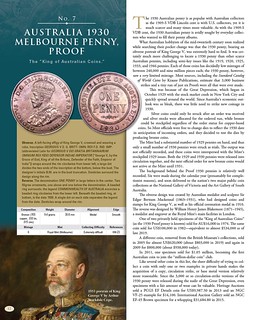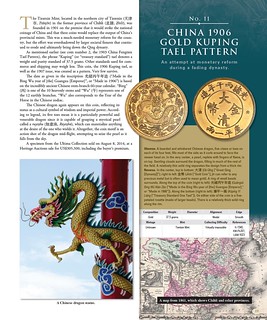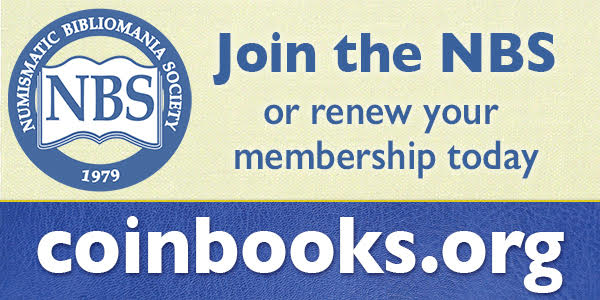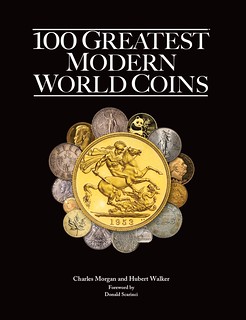
PREV ARTICLE
NEXT ARTICLE
FULL ISSUE
PREV FULL ISSUE
BOOK REVIEW: 100 GREATEST MODERN WORLD COINSDennis Tucker of Whitman Publishing forwarded this review by Don Scarinci on the new book 100 Greatest Modern World Coins, written by our friends at CoinWeek, Charles Morgan and Hubert Walker. Thanks! -Editor Donald Scarinci on the 100 Greatest Modern World Coins In March 2020 Whitman Publishing will release 100 Greatest Modern World Coins, by numismatists Charles Morgan and Hubert Walker. The 168-page coffee-table hardcover will be available from booksellers and hobby shops nationwide, and online (including at www.Whitman.com). Here, medallic-art historian Donald Scarinci shares his thoughts on modern world coinage and the new book.
Those 100 or so years were a time of great transition in just about every aspect of life. In numismatics, they were a bridge between the classic designs of the great eighteenth- and nineteenth-century engravers, like Pierre-Simon-Benjamin Duvivier and William Wyon, and the contemporary masterpieces of sculptors such as Herbert Wähner and Donald N. Everhart Jr. Strong Demand for Coins and the Technological Changes to Meet that Demand Historically, demand for coins and advances in technology may be the two most significant variables that influenced coin design. As demand for coins in commerce increased in the ancient world, their methods of production improved and the number of mints increased. Demand continued to increase from the seventeenth century forward. Manufacturing methods improved and the demand was met on a widespread scale. Instead of each coin being individually hammered by hand, mechanically operated devices increased the speed and efficiency of production. As the speed of production increased, the need for artists to design the coins expanded. New technology assisted the designers just as it increased the production of coins. A medieval hammered coin looks very different from a coin produced on a screw press or a steam press. All coins made after the invention and widespread use of the Janvier reducing machine look very different from the coins made before. In the nineteenth century the Janvier allowed sculptors to participate in what had theretofore been the province of engravers. The sculptors brought a new eye to coin design and saw coins as three-dimensional objects, like bas relief and sculpture. They could sculpt a 12-inch bas relief, put it on the Janvier, and reduce the sculpture to a 40 mm stackable coin. In the modern era, before credit and debit cards, more people than ever before in the history of the world used coins and paper currency to transact business. Their coins needed to be functional for everyday use. It is no surprise, therefore, that the design trends in the decorative arts—art nouveau, beaux arts, art deco—and not trends such as expressionism, cubism, surrealism, modernism, or post-modernism came to dominate coin and medal design before the 1960s. It can be argued whether the involvement of sculptors in coin design made coins more aesthetically competitive or whether the marketplace demanded more pleasing coin designs and mints responded to the demand. It is certain, however, that while function has driven the weight, size, and shape of the coins of the modern era, sculptors have driven the excellence of coin designs. For Modern Coins, the Art is as Important as the Historical Context Collectors who discover these “bridge” coins that we have labeled “modern” have a unique opportunity to understand the world nation-by-nation. The 1907-S peso from the Philippines makes a statement about that country and its relationship with America, just as the 1938 pattern penny of Ireland teaches something about the sentiment of the Irish people when they changed the inscription from Saorstát Éireann (Irish Free State) to Eire. When we study the coinage of the modern era, we begin to appreciate the importance of the art as much as the subject matter it conveys and the importance of a coin in its historical context. Increasingly, modern coins are studied and appreciated almost more for their art than for their history. With modern coins, numismatists strive to understand the life and work of artists such as Georges Guiraud, who designed the 1950 50 franc, and Giuseppe Romagnoli, who designed the impressive 1928 20 lire. The trend is toward understanding the art of coins and the work of the artists who make them. Beginning in 1982, coin designs and artists were singled out with recognitions like the Krause Coin of the Year Award. At many world mints, the designs on coins are reviewed and approved by committees rather than by individuals, thereby creating a written numismatic record. The advent of computer modeling in the twenty-first century allows artists to translate two-dimensional drawings into three-dimensional coins. Today, graphic artists are replacing sculptors in the same way that sculptors replaced engravers in the 1800s when the Janvier reducing machine was introduced. Fortunately, sculptors are still required in the translation process, but this too will likely change.   Assembling Your Own Great Coin Collection Morgan and Walker's 100 Greatest Modern World Coins debunks the notion that coins of the modern era are too common to warrant much of a premium for collecting purposes. However, the emphasis on rarity in this latest “100 Greatest” book should not deter collectors who are interested in the coins of this important period. Coins of the late nineteenth and early twentieth centuries were manufactured in the millions. Accordingly, they are often available quite inexpensively. The challenge with collecting modern coins is not so much the scarcity of the coins, but the scarcity of the condition. The best uncertified modern coins often sell for just a slight premium over their less-pristine siblings. If you can grade properly and develop an interesting collecting plan, your efforts will be rewarded economically as well as by the knowledge you gain from the collecting experience. Authors Charles Morgan and Hubert Walker have created a wonderful study of modern world coinage. They cover the period of 1900 to date (extending the “modern” era to include in their rankings a half dozen significant and well-deserving coins from more recent decades), setting each coin in context and bringing each to life. 100 Greatest Modern World Coins will inspire, inform, and entertain you. Enjoy the journey and let it spark ideas for building your own significant collection. Donald Scarinci is the senior partner in one of the largest law firms in New Jersey. He has collected coins since high school. Scarinci is considered an international authority in the field of contemporary coins and medals, having assembled one of the largest privately held collections of modern and contemporary art medals in the United States. He is a life member of the American Numismatic Association and a fellow of the American Numismatic Society, where he serves as chairman of the J. Sanford Saltus Award Committee for excellence in medallic art. He is also the ranking member (serving since 2005) of the U.S. Treasury Department's Citizens Coinage Advisory Committee. He has written four books, including Coin of the Year, published in English and Chinese by Krause Publications, where he continues to lend his expertise as one of the ten prime Coin of the Year nominators. 100 Greatest Modern World Coins
To read the earlier E-Sylum article, see:
 Wayne Homren, Editor The Numismatic Bibliomania Society is a non-profit organization promoting numismatic literature. See our web site at coinbooks.org. To submit items for publication in The E-Sylum, write to the Editor at this address: whomren@gmail.com To subscribe go to: https://my.binhost.com/lists/listinfo/esylum All Rights Reserved. NBS Home Page Contact the NBS webmaster 
|
